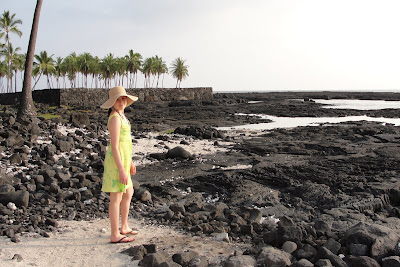Just by looking out the rental car window, one can marvel at the diverse landscapes on any side of the island. Why is that? Well, there are 13 microclimates on this planet, and the Big Island happens to host 11 of them. That's 11 comp
 letely diverse ecosystems, making this island any visitor's science lesson. Today my family ventured out on Palani Rd and drove for about 7 miles up the mountain, despite the "No Outlet" sign. We knew that we were driving straight into a foggy haze. As our van crept higher and higher, we noticed the lush vegetation (mango trees at first, but then mostly fern). As a matter of fact, there were some precious estates tucked up here. The air felt great: the fog was refreshing and it was like stepping out of a shower (not like any San Francisco fog blast). Pretty soon we couldn't see in front of us. We also noticed some birds frolicking on the side of the road; according to our guidebook, they were renegade peacocks. So, we finally reached a dead end. The funny thing is that we were all afraid to get out of the car: the hill was so steep and we were worried that the emergency brake would let us down! But anyway, we crept out. On a good day, we might have spotted some views of volcanoes. But not today. So we stayed up there, took pictures, enjoyed yet another diverse ecosystem of the island and headed back down. (Might I add that my mom refused to sit in the car as my dad declined down the hill-- we walked halfway down!).
letely diverse ecosystems, making this island any visitor's science lesson. Today my family ventured out on Palani Rd and drove for about 7 miles up the mountain, despite the "No Outlet" sign. We knew that we were driving straight into a foggy haze. As our van crept higher and higher, we noticed the lush vegetation (mango trees at first, but then mostly fern). As a matter of fact, there were some precious estates tucked up here. The air felt great: the fog was refreshing and it was like stepping out of a shower (not like any San Francisco fog blast). Pretty soon we couldn't see in front of us. We also noticed some birds frolicking on the side of the road; according to our guidebook, they were renegade peacocks. So, we finally reached a dead end. The funny thing is that we were all afraid to get out of the car: the hill was so steep and we were worried that the emergency brake would let us down! But anyway, we crept out. On a good day, we might have spotted some views of volcanoes. But not today. So we stayed up there, took pictures, enjoyed yet another diverse ecosystem of the island and headed back down. (Might I add that my mom refused to sit in the car as my dad declined down the hill-- we walked halfway down!).We got back on the road and drove north, toward Waimea. However, we didn't end up going there (don't ask me why-- navigation troubles, perhaps?) and drove 30 miles across a desert scene. Lava that had spewed in the 1800's remained, of course, and the land was dry and mostly black. So you can imagine that the drive was uneventful.
‘Anaeho’omalu Bay
Once we entered ‘Anaeho’omalu Bay 45 minutes later, all was forgiven. This bay, known simply as A Bay, was a pristine spot for windsurfing, parasailing and 
Donkey Balls at Surfin’ Ass
Why would anyone enter such a profound store like this? Well, turns out that these balls are seriously ono, or delicious. Yup, with at least ten varieties, these chocolate covered macadamia nuts are famous on the Big Island
The Painted Church
Heading south, we turned off the highway to visit the Painted Church, also known as the St. Benedict’s Catholic Church. The view of Kealakeku
The view of Kealakeku a Bay is amazing and the church grounds are quaint. The doors to the chapel, built in 1842, are wide open. Inside, religious scenes adorn the walls and ceilings, painted by one devoted Father John Velge more than 150 years ago. Mass services are still held here each Sunday, and quite frankly, it seems likes churchgoers are in for a treat coming here. It’s definitely a great place to peak in, regardless of your beliefs.
a Bay is amazing and the church grounds are quaint. The doors to the chapel, built in 1842, are wide open. Inside, religious scenes adorn the walls and ceilings, painted by one devoted Father John Velge more than 150 years ago. Mass services are still held here each Sunday, and quite frankly, it seems likes churchgoers are in for a treat coming here. It’s definitely a great place to peak in, regardless of your beliefs.
Pu’uhonua o Honaunau Historic National Park (Place of Refuge)
After leaving this sanctuary, I wondered out loud, “If I became a park ranger, could I choose this park to work in?” because  of its serenity and awe. Back in the 16th century, when the strict kapu system
of its serenity and awe. Back in the 16th century, when the strict kapu system 


No comments:
Post a Comment